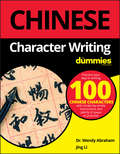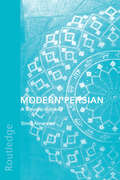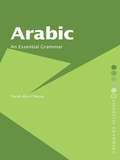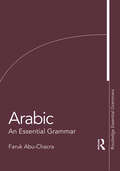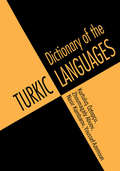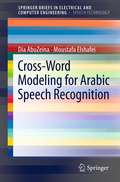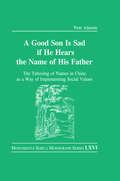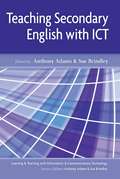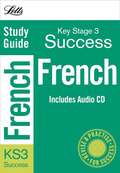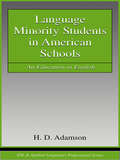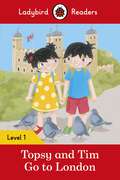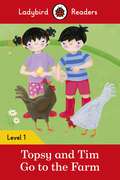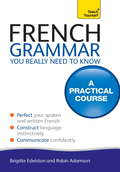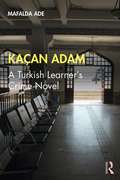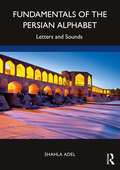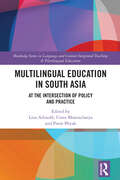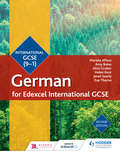- Table View
- List View
Chinese Character Writing For Dummies
by Wendy Abraham Jing LiLearn to write 100 characters in Chinese Billions of people worldwide speak Chinese—and now you can learn to write 100 characters in the world’s most-spoken language! Whether you’re taking a course, looking to get ahead at work, or just want to up the ante when you’re communicating with Chinese-speaking family and friends, Chinese Character Writing For Dummies gets you up to speed fast. This workbook will guide your first steps in learning Chinese characters. It contains 100 basic characters, including 44 simple characters (pictograms and symbols) and 56 composite characters (ideograms and ideo-phonograms). It helps you little by little to familiarize yourself with the pieces of the puzzle most frequently used, as well as some basic Chinese writing rules. Offers online bonus content that includes instructional videos, downloadable flashcards, and printable writing pages Shows you how to write 100 Chinese characters Provides instruction for beginners, students, and lifelong learners Gives you helpful tips on how to memorize characters Speaking Chinese will take you far—and learning to write some of the most common characters will only take you farther! Find out how Chinese Character Writing For Dummies can help you today!
Chinese Character Writing For Dummies
by Wendy Abraham Jing LiLearn to write 100 characters in Chinese Billions of people worldwide speak Chinese—and now you can learn to write 100 characters in the world’s most-spoken language! Whether you’re taking a course, looking to get ahead at work, or just want to up the ante when you’re communicating with Chinese-speaking family and friends, Chinese Character Writing For Dummies gets you up to speed fast. This workbook will guide your first steps in learning Chinese characters. It contains 100 basic characters, including 44 simple characters (pictograms and symbols) and 56 composite characters (ideograms and ideo-phonograms). It helps you little by little to familiarize yourself with the pieces of the puzzle most frequently used, as well as some basic Chinese writing rules. Offers online bonus content that includes instructional videos, downloadable flashcards, and printable writing pages Shows you how to write 100 Chinese characters Provides instruction for beginners, students, and lifelong learners Gives you helpful tips on how to memorize characters Speaking Chinese will take you far—and learning to write some of the most common characters will only take you farther! Find out how Chinese Character Writing For Dummies can help you today!
Modern Persian: A Course-Book
by Simin AbrahamsModern Persian begins with the teaching of the Persian alphabet. It aims to provide the student with the necessary skills for social interaction, as well as a basis for the study of modern literature. The course consists of seventeen units and favours teaching by communicative and contextual learning. Most units begin with a reading exercise used to introduce an item of grammar and new vocabulary, followed by explanations and drill exercises aimed at consolidating the student's understanding. Complete with Persian-English vocabulary to all the exercises and tape recordings, this is an up-to-date textbook which can be used both by teachers or individuals wishing to learn Persian independently.
Modern Persian: A Course-Book
by Simin AbrahamsModern Persian begins with the teaching of the Persian alphabet. It aims to provide the student with the necessary skills for social interaction, as well as a basis for the study of modern literature. The course consists of seventeen units and favours teaching by communicative and contextual learning. Most units begin with a reading exercise used to introduce an item of grammar and new vocabulary, followed by explanations and drill exercises aimed at consolidating the student's understanding. Complete with Persian-English vocabulary to all the exercises and tape recordings, this is an up-to-date textbook which can be used both by teachers or individuals wishing to learn Persian independently.
Arabic: An Essential Grammar
by Faruk Abu-ChacraArabic: An Essential Grammar is an up-to-date and practical reference guide to the most important aspects of the language. Suitable for beginners, as well as intermediate students, this book offers a strong foundation for learning the fundamental grammar and structure of Arabic. The complexities of the language are set out in short, readable sections, and exercises and examples are provided throughout. The book is ideal for independent learners as well as for classroom study. Features of this book include: coverage of the Arabic script and alphabet a chapter on Arabic handwriting a guide to pronunciation full examples throughout.
Arabic: An Essential Grammar
by Faruk Abu-ChacraArabic: An Essential Grammar is an up-to-date and practical reference guide to the most important aspects of the language. Suitable for beginners, as well as intermediate students, this book offers a strong foundation for learning the fundamental grammar and structure of Arabic. The complexities of the language are set out in short, readable sections, and exercises and examples are provided throughout. The book is ideal for independent learners as well as for classroom study. Features of this book include: coverage of the Arabic script and alphabet a chapter on Arabic handwriting a guide to pronunciation full examples throughout.
Arabic: An Essential Grammar (Routledge Essential Grammars)
by Faruk Abu-ChacraThis new edition of Arabic: An Essential Grammar is an up-to-date and practical reference guide to the most important aspects of the language. Suitable for beginners, as well as intermediate students, the book offers a strong foundation for learning the fundamental grammar and structure of Arabic. The complexities of the language are set out in short, readable sections, while exercises and examples are provided throughout. Features of this new edition include: coverage of the Arabic script and alphabet a chapter on Arabic handwriting a guide to pronunciation full examples throughout. Ideal for independent learners and for classroom study, Arabic: An Essential Grammar is the complete reference guide to the most important aspects of modern literary Arabic.
Dictionary of Turkic Languages
by Zhoumagaly Abuov Nasir Kambarov Youssef AzemounThis multi-language dictionary covers the eight major Turkic languages: Turkish, Azerbaijani, Turkmen, Uzbek, Uighur, Kazakh, Kirgiz, and Tatar. 2000 headwords in English are translated into each of the eight Turkic languages. Words are organized both alphabetically and topically. Original script and Latin transliteration are provided for each language. For ease of use, alphabetical indices are also given for the eight languages. This is an invaluable reference book for both students and learners and for those enaged in international commerce, research, diplomacy and academic and cultural exchange.
Cross-Word Modeling for Arabic Speech Recognition (SpringerBriefs in Speech Technology)
by Dia AbuZeina Moustafa ElshafeiCross-Word Modeling for Arabic Speech Recognition utilizes phonological rules in order to model the cross-word problem, a merging of adjacent words in speech caused by continuous speech, to enhance the performance of continuous speech recognition systems. The author aims to provide an understanding of the cross-word problem and how it can be avoided, specifically focusing on Arabic phonology using an HHM-based classifier.
Good Son is Sad If He Hears the Name of His Father: The Tabooing of Names in China as a Way of Implementing Social Values
by Piotr AdamekWhen in 1775 the scholar Wang Xihou compiled a dictionary called Ziguan , he wrote, for illustrative purposes, the personal names of Confucius and the three emperors Kangxi, Yongzheng and Qianlong in the introduction. In oversight, he recorded their complete names. This accidental writing of a few names was condemned by Emperor Qianlong as an unprecedented crime, rebellion and high treason. Wang Xihou was executed, his property confiscated and his books were burnt. His family was arrested and his sons and grandsons were killed or sent as slaves to Heilongjiang. It is surprising what an enormous impact the tabooing of names (bihui ) had on Chinese culture. The names of sovereigns, ancestors, officials, teachers, and even friends were all considered taboo, in other words it was prohibited to pronounce them or to record them in writing. In numerous cases characters identical or similar in writing or pronunciation were often avoided as well. The tabooing of names was observed in the family and on the street, in the office and in the emperor's palace. The practice of bihui had serious consequences for the daily lives of the Chinese and for Chinese historiography. People even avoided certain places and things, and refused to accept offices. They were punished and sometimes even killed in connection with the tabooing of names. The bihui custom existed as an important element of Chinese culture and was perceived as significant by Chinese and foreigners alike. It was crucial for implementing social values and demonstrating the political hierarchy. The present work A Good Son Is Sad if He Hears the Name of His Father is a systematic study of Chinese name-tabooing customs, which until now have been relatively little explored in Western-language Sinological studies. It attempts to provide a long-term perspective on the changing dynamics of tabooing and elucidates various aspects related to the fascinating topic of tabooing of names.
Good Son is Sad If He Hears the Name of His Father: The Tabooing of Names in China as a Way of Implementing Social Values (Monumenta Serica Monograph Ser.)
by Piotr AdamekWhen in 1775 the scholar Wang Xihou compiled a dictionary called Ziguan , he wrote, for illustrative purposes, the personal names of Confucius and the three emperors Kangxi, Yongzheng and Qianlong in the introduction. In oversight, he recorded their complete names. This accidental writing of a few names was condemned by Emperor Qianlong as an unprecedented crime, rebellion and high treason. Wang Xihou was executed, his property confiscated and his books were burnt. His family was arrested and his sons and grandsons were killed or sent as slaves to Heilongjiang. It is surprising what an enormous impact the tabooing of names (bihui ) had on Chinese culture. The names of sovereigns, ancestors, officials, teachers, and even friends were all considered taboo, in other words it was prohibited to pronounce them or to record them in writing. In numerous cases characters identical or similar in writing or pronunciation were often avoided as well. The tabooing of names was observed in the family and on the street, in the office and in the emperor's palace. The practice of bihui had serious consequences for the daily lives of the Chinese and for Chinese historiography. People even avoided certain places and things, and refused to accept offices. They were punished and sometimes even killed in connection with the tabooing of names. The bihui custom existed as an important element of Chinese culture and was perceived as significant by Chinese and foreigners alike. It was crucial for implementing social values and demonstrating the political hierarchy. The present work A Good Son Is Sad if He Hears the Name of His Father is a systematic study of Chinese name-tabooing customs, which until now have been relatively little explored in Western-language Sinological studies. It attempts to provide a long-term perspective on the changing dynamics of tabooing and elucidates various aspects related to the fascinating topic of tabooing of names.
Teaching Secondary English with ICT (UK Higher Education OUP Humanities & Social Sciences Education OUP)
by Anthony Adams Sue BrindleyHow can secondary English teaching and learning be enhanced by the use of ICT?What is the current research knowledge about teaching and learning secondary English with ICT?What good examples of using ICT in secondary English can be found in classrooms nationally and internationally?Teaching Secondary English with ICT uses best practice and research based findings to examine the potential of ICT in English teaching. It explores examples of successful work involving the use of ICT in speaking, listening, reading and writing, with a focus on the new literacies and how ICT shapes new language and literature experiences with in the English classroom.Drawing on the expertise of international figures in the field, classroom teachers and academic researchers; the book highlights ‘good practice’ in accessible discussions on research findings, with an emphasis on the interplay between classroom and theoretical approaches across a number of countries.Inviting critical engagement with key ideas on teaching with ICT, this book is essential reading for teachers and teachers in training, as well as other education professionals.
Letts Study Guide: Key Stage 3 Success French (PDF)
by Julie AdamsThis volume is full of activities, as well as a host of useful features, intended to aid understanding and a fuller appreciation of the French language and culture.
Language Minority Students in American Schools: An Education in English (ESL & Applied Linguistics Professional Series)
by H. D. AdamsonThis book addresses questions of language education in the United States, focusing on how to teach the 3.5 million students in American public schools who do not speak English as a native language. These students are at the center of a national debate about the right relationship among ESL, bilingual, and mainstream classes. Bilingual education has been banned by constitutional amendment in California and Arizona, and similar amendments are being considered in other states. Language Minority Students in American Schools: An Education in English places this debate and related issues of teaching standard English to speakers of nonstandard dialects, such as black English, within the larger context of language acquisition theory and current methods of language teaching. Adamson draws from the large body of sociolinguistic, psycholinguistic, and educational research, and on his own experience as an English teacher in the U.S. and overseas, to shed light on some of these controversies and on the cognitive, cultural, public policy, and practical issues involved in educating English language learners. Presenting all sides of the issues fairly, he offers a strong endorsement for bilingual and bidialectical education based on programs designed and administered according to the principles discussed in the book and supported by language acquisition theory and classroom research. A strength of the book is the inclusion of original research conducted in a middle school enrolling a majority of Latino students. This research contributes to the field of language education by providing a detailed description of how English language learners study content subjects. Examples from the study are used to illustrate a discussion of Vygotskian learning principles and the relationship between the students' home and school cultures. Language Minority Students in American Schools: An Education in English is intended for students who are preparing to become teachers of English as a second language, and for teachers of other subjects who work with English language learners.
Language Minority Students in American Schools: An Education in English (ESL & Applied Linguistics Professional Series)
by H. D. AdamsonThis book addresses questions of language education in the United States, focusing on how to teach the 3.5 million students in American public schools who do not speak English as a native language. These students are at the center of a national debate about the right relationship among ESL, bilingual, and mainstream classes. Bilingual education has been banned by constitutional amendment in California and Arizona, and similar amendments are being considered in other states. Language Minority Students in American Schools: An Education in English places this debate and related issues of teaching standard English to speakers of nonstandard dialects, such as black English, within the larger context of language acquisition theory and current methods of language teaching. Adamson draws from the large body of sociolinguistic, psycholinguistic, and educational research, and on his own experience as an English teacher in the U.S. and overseas, to shed light on some of these controversies and on the cognitive, cultural, public policy, and practical issues involved in educating English language learners. Presenting all sides of the issues fairly, he offers a strong endorsement for bilingual and bidialectical education based on programs designed and administered according to the principles discussed in the book and supported by language acquisition theory and classroom research. A strength of the book is the inclusion of original research conducted in a middle school enrolling a majority of Latino students. This research contributes to the field of language education by providing a detailed description of how English language learners study content subjects. Examples from the study are used to illustrate a discussion of Vygotskian learning principles and the relationship between the students' home and school cultures. Language Minority Students in American Schools: An Education in English is intended for students who are preparing to become teachers of English as a second language, and for teachers of other subjects who work with English language learners.
Ladybird Readers Level 1 - Topsy and Tim - Go to London (Ladybird Readers)
by Jean Adamson LadybirdTopsy and Tim are going to London with Mommy and Dad. They see the Tower of London and go on a boat. London is great! Ladybird Readers is a graded reading series of traditional tales, popular characters, modern stories, and non-fiction, written for young learners of English as a foreign or second language.Beautifully illustrated and carefully written, the series combines the best of Ladybird content with the structured language progression that will help children develop their reading, writing, speaking, listening and critical thinking skills.The five levels of Readers and Activity Books follow the CEFR framework and include language activities that provide preparation for the Cambridge English: Young Learners (YLE) Starters, Movers and Flyers exams. Topsy and Tim: Go to London, a Level 1 Reader, is Pre-A1 in the CEFR framework and supports YLE Starters exams. Short sentences contain a maximum of two clauses, using the present tense and some simple adjectives.
Ladybird Readers Level 1 - Topsy and Tim - Go to the Farm (Ladybird Readers)
by Jean Adamson LadybirdTopsy and Tim like going to the farm. They help the farmer, get some eggs, see the animals, and give a calf some milk.Ladybird Readers is a graded reading series of traditional tales, popular characters, modern stories, and non-fiction, written for young learners of English as a foreign or second language.Beautifully illustrated and carefully written, the series combines the best of Ladybird content with the structured language progression that will help children develop their reading, writing, speaking, listening and critical thinking skills.The eight levels of Readers and Activity Books follow the CEFR framework and include language activities that provide preparation for the Cambridge English: Young Learners (YLE) Starters, Movers and Flyers exams.Topsy and Tim Go to the Farm, a Level 1 Reader, is Pre-A1 in the CEFR framework and supports YLE Starters exams. Short sentences contain a maximum of two clauses, using the present tense and some simple adjectives.
French Grammar You Really Need To Know: Teach Yourself Ebook (Teach Yourself Language Reference)
by Robin AdamsonComprehensive and clear explanations of key grammar patterns and structures are reinforced and contextualized through authentic materials. You will not only learn how to construct grammar correctly, but when and where to use it so you sound natural and appropriate. French Grammar You Really Need to Know will help you gain the intuition you need to become a confident communicator in your new language.
Kaçan Adam: A Turkish Learner’s Crime Novel
by Mafalda AdeAimed at intermediate Turkish learners, Kaçan Adam: A Turkish Learner’s Crime Novel is a short mystery / detective story in idiomatic Turkish complete with exercises, vocabulary and grammar review. Over the course of 24 lively chapters, it follows the fate of former intelligence officer Erkan Demirel, who has been convicted of selling secret military documents but who manages to escape from prison and embarks on a quest to prove his innocence… For use either as a supplement to classroom instruction (CEFR A2-B1 and ACTFL, Lower Intermediate Level) or individually, this book will guide students through their first complete novel in Turkish while revising and reinforcing key points of modern Turkish grammar and expression.
Kaçan Adam: A Turkish Learner’s Crime Novel
by Mafalda AdeAimed at intermediate Turkish learners, Kaçan Adam: A Turkish Learner’s Crime Novel is a short mystery / detective story in idiomatic Turkish complete with exercises, vocabulary and grammar review. Over the course of 24 lively chapters, it follows the fate of former intelligence officer Erkan Demirel, who has been convicted of selling secret military documents but who manages to escape from prison and embarks on a quest to prove his innocence… For use either as a supplement to classroom instruction (CEFR A2-B1 and ACTFL, Lower Intermediate Level) or individually, this book will guide students through their first complete novel in Turkish while revising and reinforcing key points of modern Turkish grammar and expression.
Fundamentals of the Persian Alphabet: Letters and Sounds
by Shahla AdelFundamentals of the Persian Alphabet introduces complete beginners to the letters and sounds of Persian through pronunciation, basic vocabulary and phrases, conversation, and Persian culture. Students are also introduced to the distinction between the formal and informal forms of the language. As knowledge of letter–sound correspondence and phonological awareness is key to language learning, this textbook ensures learners start their learning journey with a strong foundation. This book is divided into six lessons presenting the modern Persian alphabet in groups of mostly similarly shaped letters that will allow learners to begin blending letters and segmenting words as soon as possible to make learning easier. With the guidance of additional audio and video resources, a comprehensive Persian–English glossary, and listening, speaking, reading, and writing exercises throughout the book, students will acquire the fundamental skills and knowledge for furthering their learning of the language. The ideal starting point for beginners, Fundamentals of the Persian Alphabet is designed for learners with very little or no previous knowledge of the language and is suitable for both independent and class-based study.
Fundamentals of the Persian Alphabet: Letters and Sounds
by Shahla AdelFundamentals of the Persian Alphabet introduces complete beginners to the letters and sounds of Persian through pronunciation, basic vocabulary and phrases, conversation, and Persian culture. Students are also introduced to the distinction between the formal and informal forms of the language. As knowledge of letter–sound correspondence and phonological awareness is key to language learning, this textbook ensures learners start their learning journey with a strong foundation. This book is divided into six lessons presenting the modern Persian alphabet in groups of mostly similarly shaped letters that will allow learners to begin blending letters and segmenting words as soon as possible to make learning easier. With the guidance of additional audio and video resources, a comprehensive Persian–English glossary, and listening, speaking, reading, and writing exercises throughout the book, students will acquire the fundamental skills and knowledge for furthering their learning of the language. The ideal starting point for beginners, Fundamentals of the Persian Alphabet is designed for learners with very little or no previous knowledge of the language and is suitable for both independent and class-based study.
Multilingual Education in South Asia: At the Intersection of Policy and Practice (Routledge Series in Language and Content Integrated Teaching & Plurilingual Education)
by Lina Adinolfi Usree Bhattacharya Prem PhyakSpanning scholarly contributions from India, Nepal, Bangladesh, Pakistan, and Sri Lanka, this edited volume seeks to capture and elucidate the distinct challenges, approaches and possible solutions associated with interpreting, adapting and applying language-in-education policies in a range of linguistically complex teaching and learning environments across South Asia. Centring on-the-ground perspectives of scholars, practitioners, pupils, parents and the larger community, the volume offers new insights into one of the most complex, populous, and diverse multilingual educational contexts in the world. Language-in-education policies and practices within this setting represent particularly high stakes issues, playing a pivotal role in determining access to literacy, thereby forming a critical pivot in the reproduction of educational inequality. The broad aim of the collection is thus to highlight the pedagogical, practical, ideological and identity-related implications arising from current language-in-education policies in this region, with the aim of illustrating how systemic inequality is intertwined with such policies and their associated interpretations. Aimed at both academics and practitioners - whether researchers and students in the fields of education, linguistics, sociology, anthropology or South Asian studies, on the one hand, or language policy advisors, curriculum developers, teacher educators, teachers, and members of funding bodies, aid providers or NGOs, on the other - it is anticipated that the accounts in this volume will offer their readership opportunities to consider their wider implications and applications across other rich multilingual settings – be these local, regional, national or global.
Multilingual Education in South Asia: At the Intersection of Policy and Practice (Routledge Series in Language and Content Integrated Teaching & Plurilingual Education)
by Lina Adinolfi Usree Bhattacharya Prem PhyakSpanning scholarly contributions from India, Nepal, Bangladesh, Pakistan, and Sri Lanka, this edited volume seeks to capture and elucidate the distinct challenges, approaches and possible solutions associated with interpreting, adapting and applying language-in-education policies in a range of linguistically complex teaching and learning environments across South Asia. Centring on-the-ground perspectives of scholars, practitioners, pupils, parents and the larger community, the volume offers new insights into one of the most complex, populous, and diverse multilingual educational contexts in the world. Language-in-education policies and practices within this setting represent particularly high stakes issues, playing a pivotal role in determining access to literacy, thereby forming a critical pivot in the reproduction of educational inequality. The broad aim of the collection is thus to highlight the pedagogical, practical, ideological and identity-related implications arising from current language-in-education policies in this region, with the aim of illustrating how systemic inequality is intertwined with such policies and their associated interpretations. Aimed at both academics and practitioners - whether researchers and students in the fields of education, linguistics, sociology, anthropology or South Asian studies, on the one hand, or language policy advisors, curriculum developers, teacher educators, teachers, and members of funding bodies, aid providers or NGOs, on the other - it is anticipated that the accounts in this volume will offer their readership opportunities to consider their wider implications and applications across other rich multilingual settings – be these local, regional, national or global.
Edexcel International GCSE German Student Book (2nd Edition) (PDF)
by Mariela Affum Amy Bates Alice Gruber Helen Kent Janet Searle Zoe ThorneA grammar-led approach with extensive exam preparation that will help develop independent, culturally aware students.- Develop students' ability to use languages effectively- Stretch and challenge students to achieve their best grades- Ensure the progression required for further study at A-level or equivalent- Provide insight and encourage a positive attitude towards other culturesThese books are written to the latest Edexcel specification by experienced teachers. Extensive use of the language reflects the style of the exams and, with specific exam advice and practice, it helps to build all the skills needed for success. Topics on cultures are integrated throughout to ensure students gain the cultural awareness that is at the heart of this qualification.These books provide up-to-date content following a clear sequencing of topics designed specifically for teaching Languages at this level. They are designed to develop spontaneous, confident linguists who are able to progress to further study.- Teacher Resource + Audio-CDs (ISBN 9781510403338)- Grammar Workbook (ISBN 9781471833151)
